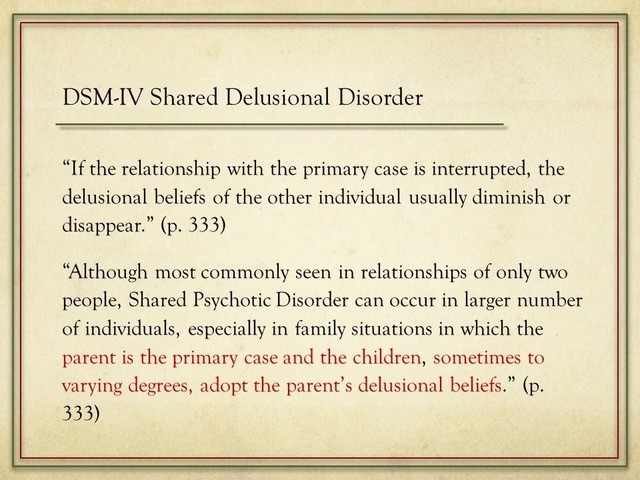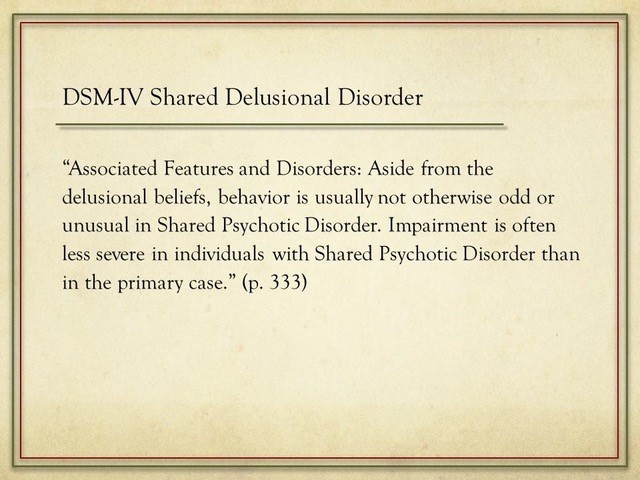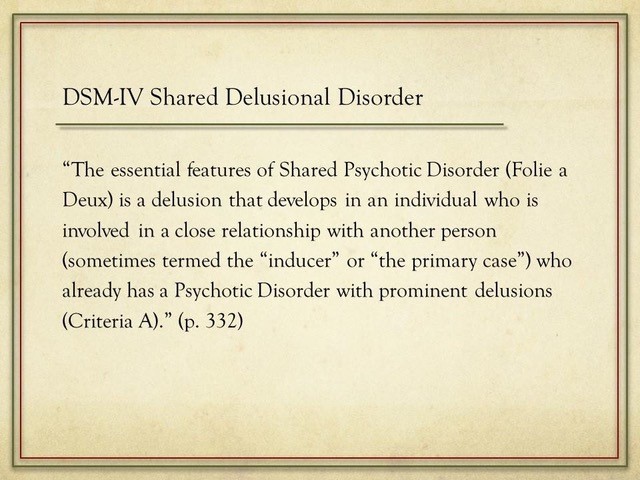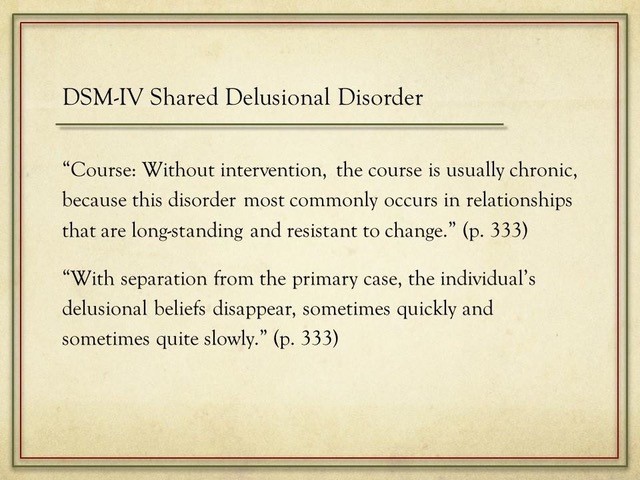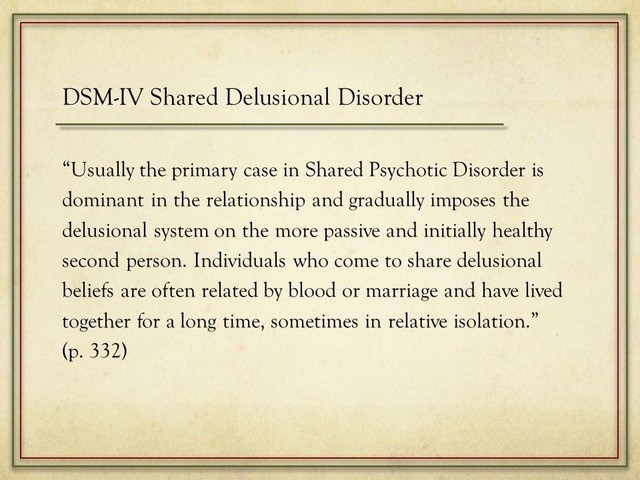I know, we're on the DSM-5 now, but the DSM-IV is still a product of the American Psychiatric Association based on large amounts of research evidence. I'm just wondering, ever read it?
There is a diagnosis in the DSM-IV of Shared Psychotic Disorder. It was taken out of the DSM-5 as a stand-alone diagnosis and placed over in the Delusional Disorder diagnosis. But the diagnosis of Shared Psychotic Disorder is still in the ICD-10 system of the World Health Organization; F24.
I believe all insurance company billing in the U.S. requires an ICD-10 diagnosis, and I think the rest of the world relies on the ICD-10 system. The ICD-10 diagnosis code for a shared delusion is F24. But ICD-10 doesn't actually offer much explanation for the pathology.
For a good explanation of the pathology of a shared delusional disorder, we have to turn to the American Psychiatric Association and the DSM-IV.
Ever read the DSM-IV diagnosis of a Shared Psychotic Disorder? It's pretty interesting. Here's what the American Psychiatric Association says about the pathology of a shared delusional disorder.
From the APA: “Usually the primary case in Shared Psychotic Disorder is dominant in the relationship and gradually imposes the delusional system on the more passive and initially healthy second person. Individuals who come to share delusional beliefs are often related by blood or marriage and have lived together for a long time, sometimes in relative isolation.” (p. 332)
Hmm, dominant in the relationship, related by blood or marriage.
From the APA: “Although most commonly seen in relationships of only two people, Shared Psychotic Disorder can occur in larger number of individuals, especially in family situations in which the parent is the primary case and the children, sometimes to varying degrees, adopt the parent’s delusional beliefs.” (p. 333)
Well that's interesting, especially in family situations where the parent is the primary case and the children, to varying degrees, adopt the parent's delusional beliefs. Sounds strikingly familiar, don't you think.
From the APA: “If the relationship with the primary case is interrupted, the delusional beliefs of the other individual usually diminish or disappear.” (p. 333)
Wow, whaddya know. A treatment recommendation for a protective separation right there from the American Psychiatric Association in the DSM-IV diagnosis of the pathology.
Did you know that? That the American Psychiatric Association reports that a protective separation of the "children" who "adopt the parent's delusional belief" from the "primary case" will recover the children's normal-range functioning .
Pretty interesting what happens when we apply the standard and scientifically established knowledge of professional psychology. My goodness gracious, a protective separation recommendation right there from the American Psychiatric Association.
What else does the APA have to say about the DSM-IV pathology of a shared delusional disorder between a parent and child?
From the APA: “Associated Features and Disorders: Aside from the delusional beliefs, behavior is usually not otherwise odd or unusual in Shared Psychotic Disorder. Impairment is often less severe in individuals with Shared Psychotic Disorder than in the primary case.” (p. 333)
So the child will do well in school, and in therapy, and in pretty much every other area of lite their "behavior is usually not otherwise odd or unusual" - except in the one area of their delusion.
What happens if we do nothing and don't stop the course of this pathology?
From the APA: “Course: Without intervention, the course is usually chronic, because this disorder most commonly occurs in relationships that are long-standing and resistant to change.” (p. 333)
Wow. Sounds like we need to do something to actively alter the course of the pathology, and it sounds hard because the pathology is "resistant to change."
But wait, if we protectively separate the child from the primary case of the parent, then didn't the APA say that the child's symptoms will "diminish or disappear"?
Does the APA have anything else to say about that?
From the APA: “With separation from the primary case, the individual’s delusional beliefs disappear, sometimes quickly and sometimes quite slowly.” (p. 333)
Wow. So the APA in their diagnostic criteria for a shared delusional disorder twice note the treatment recommendation for a protective separation, indicating that otherwise the course is "chronic" and "resistant to change."
Did you know that? That the American Psychiatric Association has identified this pathology - a shared delusional disorder, and recommends a protective separation of the child from the primary case of the delusional belief, the allied parent.
In the DSM-5 the shared delusional disorder is now buried in a Delusional Disorder diagnosis for the parent. It's hard to get at as a diagnosis for the child in the DSM-5.
It's still available in the ICD-10 diagnostic system of the World Health Organization, though. F24. But the ICD-10 doesn't describe the pathology at the level of the American Psychiatric Association. For a good description of a shared delusional disorder we have to turn to the American Psychiatric Association.
Why did the DSM-5 drop an independent diagnosis of a shared delusional disorder and move it into a feature of an individual Delusional Disorder? It's because the DSM-5 people didn't like two-person diagnoses. Medicine doesn't have two-person medical diagnoses, and psychiatrists are medical doctors, so they wanted to mimic medicine and have only one-person diagnoses in the DSM-5.
A shared delusion is a two-person diagnosis, so they moved it and tucked it away as a feature of a one person delusional disorder. Odd, but it's what they did. They'll correct that I'm sure in a future version of the DSM. Did you know that homosexuality was once a DSM pathology? They changed that with the DSM-III and they dropped homosexuality as a psychiatric disorder. They do that. Add and drop stuff.
Oh, just a note on this... do you see any "new theory" of Dr. Childress in any of this?
This is just straight American Psychiatric Association statements in their DSM diagnostic book.
It's an ICD-10 diagnosis of F24.
None of this is me. None of this is Dr. Childress. It is the established - scientifically established - knowledge of professional psychology.
Knowledge. Wow, when we apply knowledge it explains and solves a lot. Who'd of thought that this diagnosis was in the DSM-IV this entire time of the past 40 years of complex family conflict.
I wonder why no one ever applied it? Odd, don't you think. Bill Bernet, Amy Baker, Harman, anyone? Wanna take a shot at why none of you have applied this information from the American Psychiatric Association to the pathology?
Doesn't it seem relevant to you. I've been posting about this since 2012. And the DSM-IV was published in 1994. So this information has been available for applied use since the mid-90s.
I wonder why no one's applied it. Doesn't it seem relevant? It does to me.
Craig Childress Psy.D.
Clinical Psychologist, PSY 18857
